This solution works for NxN matrix of all sizes.
It returns the amount of sequences that consists of at least $consecutive_length of the same letters consecutively.
It consists of 3 parts: 1) get_count_sequences_horizontal 2) get_count_sequences_vertical and 3) get_count_sequences_oblique.
In the end it is summed up in get_count_sequences.
Here's the code. Explanation is in the comments.
<?php
function get_count_sequences_horizontal($input_dna, $consecutive_length) {
$count_sequences_horizontal = 0;
//ITERATES THROUGH EACH ROW
for($y = 0; $y < count($input_dna); $y++) {
$count_consecutive_letter = 0;
//ITERATES THROUGH EACH COLUMN
for($x = 0; $x < count($input_dna[0]) - 1; $x++) {
//COMPARES THE CURRENT VALUE WITH THE VALUE OF THE NEXT HORIZONTAL POSITION
if($input_dna[$y][$x] == $input_dna[$y][$x + 1]) {
$count_consecutive_letter++;
} else {
//IF THE COMPARISON FAILS, THE COUNTER IS RESET, BECAUSE IN A LARGE MATRIX THERE MAY BE MULTIPLE SEQUENCES OF AT LEAST 4 CONSECUTIVE LETTERS
$count_consecutive_letter = 0;
}
//IF THE COUNT_CONSECUTIVE_LETTER HAS REACHED X, THAT MEANS THAT (X + 1) LETTERS ARE CONSECUTIVE
//WHY? CCCC IS 4 LETTER SEQUENCE. C1 == C2 is 1 count, C2 == C3 is 2nd count, C3 == C4 is 3rd count. 3 counts of comparison of 4 C's
if($count_consecutive_letter == $consecutive_length - 1) {
$count_sequences_horizontal++;
}
}
}
return($count_sequences_horizontal);
}
function get_count_sequences_vertical($input_dna, $consecutive_length) {
$count_sequences_vertical = 0;
//ITERATES THROUGH EACH COLUMN
for($x = 0; $x < count($input_dna[0]); $x++) {
$count_consecutive_letter = 0;
//ITERATES THROUGH EACH ROW
for($y = 0; $y < count($input_dna) - 1; $y++) {
//COMPARES THE CURRENT VALUE WITH THE VALUE OF THE NEXT VERTICAL POSITION
if($input_dna[$y][$x] == $input_dna[$y + 1][$x]) {
$count_consecutive_letter++;
} else {
//IF THE COMPARISON FAILS, THE COUNTER IS RESET, BECAUSE IN A LARGE MATRIX THERE MAY BE MULTIPLE SEQUENCES OF AT LEAST 4 CONSECUTIVE LETTERS
$count_consecutive_letter = 0;
}
//IF THE COUNT_CONSECUTIVE_LETTER HAS REACHED X, THAT MEANS THAT (X + 1) LETTERS ARE CONSECUTIVE
//WHY? CCCC IS 4 LETTER SEQUENCE. C1 == C2 is 1 count, C2 == C3 is 2nd count, C3 == C4 is 3rd count. 3 counts of comparison of 4 C's
if($count_consecutive_letter == $consecutive_length - 1) {
$count_sequences_vertical++;
}
}
}
return($count_sequences_vertical);
}
function get_count_sequences_oblique($input_dna, $consecutive_length) {
$count_sequences_oblique = 0;
$count_consecutive_letter = 0;
//ITERATES THROUGH THE MIDDLE OBLIQUE LINE
//EXAMPLE MATRIX SQUARE:
// 1234
// 5678
// 9ABC
// DEFG
//THIS LOOPS THROUGH [1,6,B,G]
for($x = 0; $x < count($input_dna[0]) - 1; $x++) {
$y = $x;
//CHECKS $y IS WITHIN BOUNDARIES AND PERFORMS BELOW ACTIONS IF IT IS
if($y < count($input_dna) - 1) {
//COMPARES THE CURRENT VALUE WITH THE VALUE OF THE NEXT OBLIQUE POSITION
if($input_dna[$y][$x] == $input_dna[$y + 1][$x + 1]) {
$count_consecutive_letter++;
} else {
//IF THE COMPARISON FAILS, THE COUNTER IS RESET, BECAUSE IN A LARGE MATRIX THERE MAY BE MULTIPLE SEQUENCES OF AT LEAST 4 CONSECUTIVE LETTERS
$count_consecutive_letter = 0;
}
//IF THE COUNT_CONSECUTIVE_LETTER HAS REACHED X, THAT MEANS THAT (X + 1) LETTERS ARE CONSECUTIVE
//WHY? CCCC IS 4 LETTER SEQUENCE. C1 == C2 is 1 count, C2 == C3 is 2nd count, C3 == C4 is 3rd count. 3 counts of comparison of 4 C's
if($count_consecutive_letter == $consecutive_length - 1) {
$count_sequences_oblique++;
}
}
}
//ITERATES THROUGH THE RIGHT HALF SIDE THE MATRIX SQUARE
//EXAMPLE MATRIX SQUARE:
// 1234
// 5678
// 9ABC
// DEFG
//THIS LOOPS THROUGH [2,7,C], [3,8] AND [4]
for($offset_x = 1; $offset_x < count($input_dna[0]); $offset_x++) {
$count_consecutive_letter = 0;
for($x = $offset_x; $x < count($input_dna[0]) - 1; $x++) {
$y = $x - $offset_x;
//CHECKS $y IS WITHIN BOUNDARIES AND PERFORMS BELOW ACTIONS IF IT IS
if($y < count($input_dna) - 1) {
//COMPARES THE CURRENT VALUE WITH THE VALUE OF THE NEXT OBLIQUE POSITION
if($input_dna[$y][$x] == $input_dna[$y + 1][$x + 1]) {
$count_consecutive_letter++;
} else {
//IF THE COMPARISON FAILS, THE COUNTER IS RESET, BECAUSE IN A LARGE MATRIX THERE MAY BE MULTIPLE SEQUENCES OF AT LEAST 4 CONSECUTIVE LETTERS
$count_consecutive_letter = 0;
}
if($count_consecutive_letter == $consecutive_length - 1) {
$count_sequences_oblique++;
}
}
}
}
//ITERATES THROUGH THE LEFT HALF SIDE THE MATRIX SQUARE
//EXAMPLE MATRIX SQUARE:
// 1234
// 5678
// 9ABC
// DEFG
//THIS LOOPS THROUGH [5,A,F], [9,E] AND [D]
for($offset_y = 1; $offset_y < count($input_dna); $offset_y++) {
$count_consecutive_letter = 0;
for($y = $offset_y; $y < count($input_dna) - 1; $y++) {
$x = $y - $offset_y;
//CHECKS $x IS WITHIN BOUNDARIES AND PERFORMS BELOW ACTIONS IF IT IS
if($x < count($input_dna[0]) - 1) {
//COMPARES THE CURRENT VALUE WITH THE VALUE OF THE NEXT OBLIQUE POSITION
if($input_dna[$y][$x] == $input_dna[$y + 1][$x + 1]) {
$count_consecutive_letter++;
} else {
//IF THE COMPARISON FAILS, THE COUNTER IS RESET, BECAUSE IN A LARGE MATRIX THERE MAY BE MULTIPLE SEQUENCES OF AT LEAST 4 CONSECUTIVE LETTERS
$count_consecutive_letter = 0;
}
if($count_consecutive_letter == $consecutive_length - 1) {
$count_sequences_oblique++;
}
}
}
}
return($count_sequences_oblique);
}
function get_count_sequences($input_dna, $consecutive_length) {
$count_sequences = get_count_sequences_horizontal($input_dna, $consecutive_length);
$count_sequences += get_count_sequences_vertical($input_dna, $consecutive_length);
$count_sequences += get_count_sequences_oblique($input_dna, $consecutive_length);
return($count_sequences);
}
$dna = array(
array("A", "T", "G", "C", "G", "A"),
array("C", "A", "G", "T", "G", "C"),
array("T", "T", "A", "T", "G", "T"),
array("A", "G", "A", "A", "G", "G"),
array("C", "C", "C", "C", "T", "A"),
array("T", "C", "A", "C", "T", "G"),
);
echo(get_count_sequences($dna, 4));
//echo's "3", because there are 3 sequences of the 4 same letters consecutively
?>
